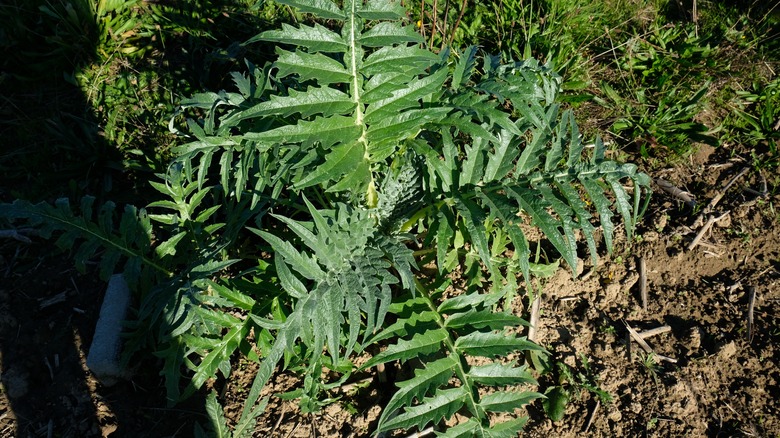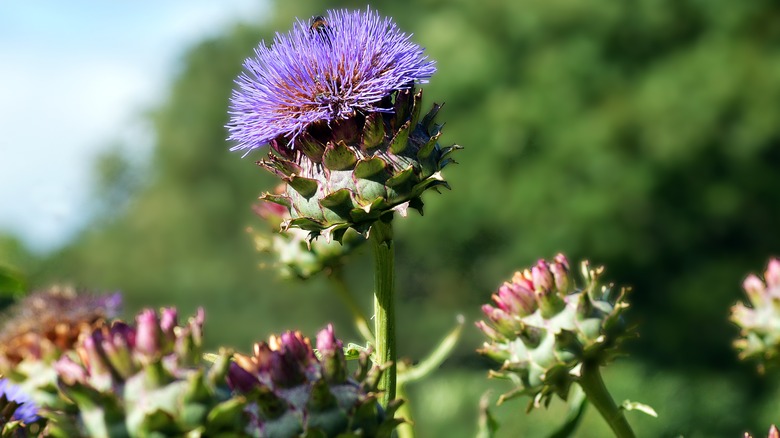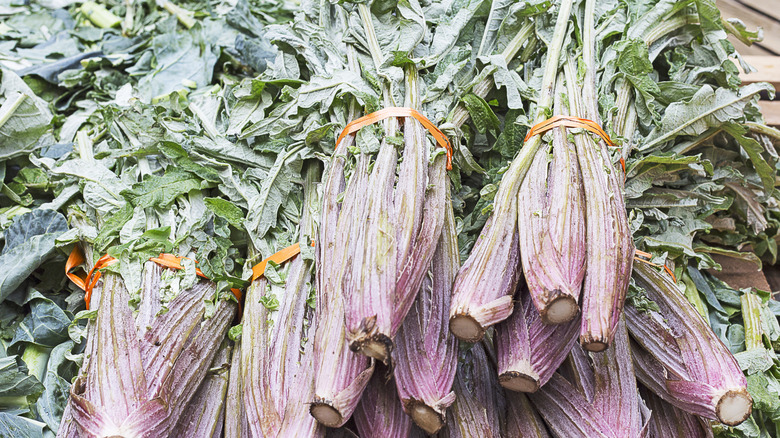Why Artichoke's Cousin Would Be A Great Addition To Your Veggie Garden
If you own a vegetable garden, then you already know the value of being able to grow your own food and herbs. Gone are the days where you troop to the grocery store every time you need a bulb of garlic or a handful of tomatoes. If you have a little extra space and you're looking for a new addition to your vegetable garden, you have to go with cardoon plants. A cousin of artichokes, cardoons offer a more robust midrib than the artichoke and come with a host of nutrients such as vitamins B5, B9, C, fiber, calcium, and potassium. The plant also produces purple flowers when it blooms, adding to the beauty of your garden.
The artichoke is actually a domesticated version of the wild cardoon, which has the official name of Cynara cardunculus. However, unlike the artichoke which is more popular for its heart, cardoons are favored for their stalks which look like celery after you cut it. The Mediterranean native also tastes similar to its artichoke relative, often described as being earthy. You don't ever have to worry about having enough cardoons because they are typically a prolific plant and will grow in a variety of soils, per Oregon State University.
There are many reasons why adding cardoons to your veggie garden would pay off greatly. Growing them is particularly high-maintenance though, so you have to know the tricks and tips to securing a bountiful harvest.
Benefits of growing cardoons
If you plan on growing cardoons in addition to all the other tasty veggies in your garden, you won't be disappointed when harvest time comes. Firstly, cardoons make great companions for many plants, including peas, sunflowers, and cucurbits like cucumber. The cardoon flower is great at attracting pollinators to the garden, benefitting other surrounding plants.
Cardoons are also believed to be deer-resistant, which means you can rest assured that the local deer population probably wouldn't want to mess with it. The leaves of the cardoon plant are pretty spiky to begin with, which is a great deterrent for foraging animals. For us humans, the edible stalks of the plant make for a nutritious addition to any meal because of the high amount of antioxidants and nutrients it possesses. The vegetable is also a great dietary option for those looking to shed a few pounds because it has a high fiber and low calorie count. You can even snack on them raw. Lastly, if for nothing else, they just look great. If decorative flowers mean anything to you, you'll appreciate the uniqueness of the plant's vibrant purple blossoms that guarantee a stop-and-sniff from any passerby.
How to take care of your cardoon
If you plan on growing a healthy garden of cardoons, then you will first need to get familiar with the properties of the plant. Cardoons are built to flourish in cooler regions with full sun, but they may survive in warmer weather. They also prefer well-drained, nutrient-rich soil. Composting before you plant the seedlings is a great way to ensure they have all the provisions that they need.
Watering your cardoons is simple enough. Stick to a regular routine, but make sure you don't overwater them or else they could get waterlogged, which can lead to root rot and death. The best method to use is to make sure the soil is completely dry between each watering session.
Regular attention should be given to your cardoon plants because they are susceptible to pests, and in particular, aphids. These pests suck the plant juice out of your cardoon leaves, leaving them stunted and wilted. Any sign of an infestation is a critical call to get rid of the aphids expeditiously so that you can minimize the damage and save the harvest. You can solve this by blasting the insects off with water.


